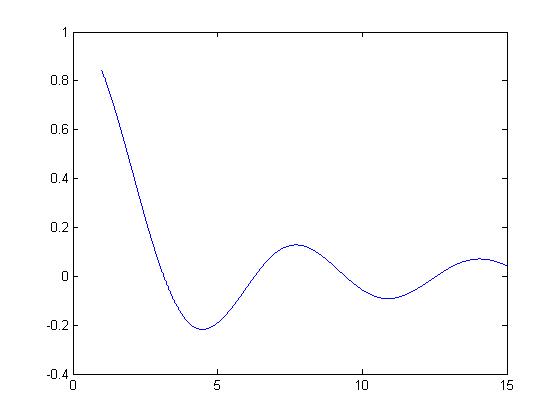(New page: ==Periodic Function== The function shown is <math>f(t) = \sin(t)</math>. Note the repetition of the function every 2\pi along the x-axis. [[Image:periodic_function.jpg|frame|center|The ...) |
|||
| (4 intermediate revisions by one other user not shown) | |||
| Line 1: | Line 1: | ||
| + | =Periodic versus non-periodic functions ([[Homework_1_ECE301Fall2008mboutin|hw1]], [[ECE301]])= | ||
| + | <span style="color:green"> Read the instructor's comments [[hw1periodicECE301f08profcomments|here]]. </span> | ||
| + | |||
==Periodic Function== | ==Periodic Function== | ||
| + | The definition of a periodic function is as follows: | ||
| + | x[n] is periodic iff there exists an integer N such that x[n+N] = x[n]. The value of N is called the "Period." | ||
| + | |||
| + | An example of a periodic function is <math>f(t) = e^{2\pi j}</math>. | ||
| + | To prove this, we do the following: | ||
| + | |||
| + | <math>x[n+N] = x[n]</math> | ||
| + | |||
| + | |||
| + | <math>e^{2\pi j (n+N)} = e^{2\pi j n}</math> | ||
| + | |||
| + | |||
| + | <math>{e^{2\pi j n} e^{2\pi j N}} = e^{2\pi j n}</math> | ||
| + | |||
| + | |||
| + | <math>e^{2\pi j N} = 1</math> | ||
| + | |||
| + | |||
| + | <math>\cos(2\pi N) + j\sin(2\pi N) = 1</math> | ||
| − | + | Which is true if | |
| − | + | <math>2\pi N = 2\pi </math> | |
| − | + | at some point. | |
| + | Since N = 1 yields <math> 2\pi = 2\pi </math>, we can conclude that in fact, <math>f(t) = e^{2\pi j}</math> is periodic. | ||
==Non-Periodic Function== | ==Non-Periodic Function== | ||
| − | The function shown is <math>f(t) = {\sin(t)\ | + | The function shown is <math>f(t) = {\sin(t)\over t}</math>. |
Note that the function never repeats itself. It changes constantly over its entire expanse. | Note that the function never repeats itself. It changes constantly over its entire expanse. | ||
| − | [[Image:non_periodic_function_ECE301Fall2008mboutin.jpg|frame|center|The function <math>f(t) = {\sin(t)\ | + | [[Image:non_periodic_function_ECE301Fall2008mboutin.jpg|frame|center|The function <math>f(t) = {\sin(t)\over t}</math> from 0 to 15.]] |
Latest revision as of 07:15, 14 April 2010
Periodic versus non-periodic functions (hw1, ECE301)
Read the instructor's comments here.
Periodic Function
The definition of a periodic function is as follows: x[n] is periodic iff there exists an integer N such that x[n+N] = x[n]. The value of N is called the "Period."
An example of a periodic function is $ f(t) = e^{2\pi j} $. To prove this, we do the following:
$ x[n+N] = x[n] $
$ e^{2\pi j (n+N)} = e^{2\pi j n} $
$ {e^{2\pi j n} e^{2\pi j N}} = e^{2\pi j n} $
$ e^{2\pi j N} = 1 $
$ \cos(2\pi N) + j\sin(2\pi N) = 1 $
Which is true if
$ 2\pi N = 2\pi $
at some point.
Since N = 1 yields $ 2\pi = 2\pi $, we can conclude that in fact, $ f(t) = e^{2\pi j} $ is periodic.
Non-Periodic Function
The function shown is $ f(t) = {\sin(t)\over t} $.
Note that the function never repeats itself. It changes constantly over its entire expanse.


